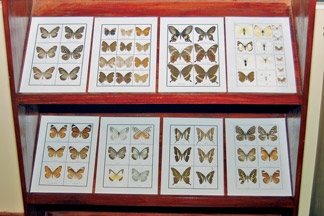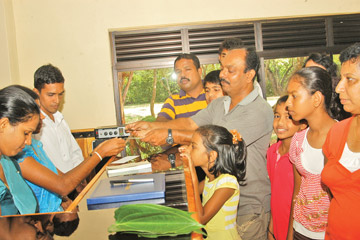Silent and still they tell a moving story
Sri Lanka’s first Natural Museum opens:
By Dhaneshi Yatawara
The room is filled with numerous animals. The leopard is in an attack
mode in one corner of the room and in another corner two palm cats and a
black monkey sit in one group. You may find a rare and precious animal -
the black leopard, inside a big glass compartment. Part of a movie? Not
really. This is what you may find inside Sri Lanka’s first natural
museum at Giritale.
|

Wild Life Ranger A.L. Jayasooriya mounting a sambur with
another colleague. |

Stuffed bear
|
Last week, Agrarian Services and Wildlife Minister S.M. Chandrasena
opened this for public view and today it has become a hot spot for
wildlife enthusiasts visiting the area. Though the main museum in
Colombo has a separate section with stuffed animals, especially those
endemic to the country, we do not own a natural museum.
The new Natural Museum is situated in the premises of the Wild Life
Training Centre in Giritale. “With this natural museum the Wild Life
Department was able to fulfil a long felt need in training and research
sectors of the country,” said Assistant Director of the Department and
the head of the training centre Gamini Samarakoon.
The museum has a number of stuffed animals belonging to many species
including rare and endemic ones. All are well preserved keeping the
natural appearance intact in the most possible way.
The most outstanding piece is the black leopard that was found dead,
caught in a trap in Ma Ulpotha, Deniyaya in the Matara district. The
carcass was found on March 6, 2009. The postmortem revealed that its
death occurred due to the severe damage to its kidneys as the wire noose
of the trap tightened around its waist. Sri Lanka lost one of the most
valuable species because of illegal poaching.
|

The Black Leopard |

Butterflies |
Today this black leopard standing still in the natural museum
silently tells of its tragic end depicting the misery such animals are
facing. Led by Wild Life Ranger A.L. Jayasooriya the taxidermy division
of the training centre is the prime mover behind these wonderful
creations. “We have highly skilled taxidermists and Jayasooriya is one
of the very few experts with long years of experience in taxidermy,”
Samarakoon explained.
The dead specimen of the black panther was collected by Wild Life
Ranger Ajith Gunatunga. Jayasooriya and Wild Life Guard K.G.P.
Nanayakkara mounted the animal which is now exhibited in the Natural
Museum.
Taxidermy, the act of preserving dead animals for display, is used
today mostly for studies though this was earlier used to create hunting
trophies. It is recorded in history books that by the 18th century
almost every town in the Western countries had a tannery business as
hunters began bringing their trophies to upholstery shops where the
upholsterers would actually sew up the animal skins and stuff them with
rags and cotton.
The term “stuffing” evolved from this crude form of taxidermy. Today
professional taxidermists prefer the term “mounting”. In the early 20th
century, taxidermy began to evolve into its modern form under leading
artists of the Western world. Taxidermy was developed in to a
professional field which was capable of re-creating anatomically
accurate figures incorporating every detail of the animal.
|

Visitors at the information desk of the museum |
|

Skeleton of a python |
Contradicting its foundation that always highlighted man’s
superiority over animals, today taxidermy focuses on re-creating animals
in postures that are considered more appropriate for each species.
“Preserving the natural look to the level best is crucial in today’s
taxidermy,” Samarakoon added. “Taxidermy is a major part every wildlife
officer has to learn.
Thus trainees made these stuffed animals and we only had them as a
collection,” Samarakoon said explaining the start of the Sri Lankan
Natural Museum. Under the direction of the present Director General of
the Wild Life Conservation Department Dr. Chandrawansa Pathiraja it was
decided to create a Natural Museum using available resources. “We have
tried our best to exhibit animals that people rarely see even if they
visit a park. Most of the endemic species are displayed here,”
Samarakoon added.
Each creation highlights the importance of every animal to the
environment while highlighting the death threats on them, especially
from humans. “A Guide will always be available for visitors to get more
details on the animals apart from what we have on display,” he said. For
the Wild Life Department this is just the start of a long journey. Using
the already available local expertise wildlife authorities believe they
can acquire an advanced Natural Museum in the years to come making
people more aware of our precious wildlife and its conservation.
Pix: Susantha Wijegunasekera
|

